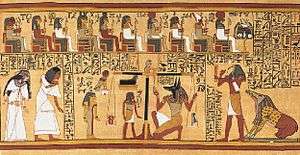Papyrus of Ani
The Papyrus of Ani is a papyrus manuscript in the form of a scroll with cursive hieroglyphs and color illustrations that was created c. 1250 BCE, during the Nineteenth Dynasty of the New Kingdom of ancient Egypt. Egyptians compiled an individualized book for certain people upon their death, called the Book of Going Forth by Day, more commonly known as the Book of the Dead, typically containing declarations and spells to help the deceased in their afterlife. The Papyrus of Ani is the manuscript compiled for the Theban scribe Ani.
| Papyrus of Ani | |
|---|---|
 Anubis weighing the heart of Ani | |
| Material | Papyrus |
| Size | Length: 67 cm (26 in) (frame) Width: 42 cm (17 in) (frame) |
| Writing | Hieroglyphic |
| Created | 1250 BCE (circa) |
| Period/culture | 19th Dynasty |
| Place | Tomb of Ani |
| Present location | British Museum, London |
| Identification | 10470,3 |
| Registration | 1888,0515.1.3 |
The scroll was discovered in Luxor in 1888 by Egyptians trading in illegal antiquities. It was acquired by E. A. Wallis Budge, as described in his autobiography By Nile and Tigris. Shortly after Budge first saw the papyrus, Egyptian police arrested several antiquities dealers and sealed up their houses, one of which contained the objects Budge had purchased from the dealers. Budge distracted the guards by offering them a meal while locals tunneled under the house's walls to retrieve the objects, including the Papyrus of Ani. Stored in several custom tin boxes, the papyrus and other objects Budge had acquired were then smuggled to the principal librarian at the British Museum.[1] Budge was afterward paid a 150GBP "gratuity" from the British Treasury on behalf of the British Museum for acquiring the papyrus.[2]
Contents
| Divisions | Sections | Title |
|---|---|---|
| 01 | 16 | Hymns |
| 02 | 36 | Praises of Khert-Neter |
| 03 | 08 | Seven Arits |
| 04 | 10 | Pylons of the House of Osiris |
| 05 | 05 | Speeches |
| 06 | 22 | Hail Thoths |
| 07 | 32 | Chapter Collection 1 |
| 08 | 20 | Homages |
| 09 | 19 | Miscellaneous (Hymns, Hails, Homage, Chapter, Rubric) |
| 10 | 18 | Chapter Collection 2 |
| 11 | 20 | Funeral Chamber Texts |
- Note: Divisions vary based on compilations; Sections are groups of related sentences; Titles are not original to the text.
References
- By Nile and Tigris : a narrative of Journeys in Egypt and Mesopotamia on behalf of the British Museum between the years 1886 and 1913 by Budge, E. A. Wallis (Ernest Alfred Wallis), Sir, 1857-1934, pp. 136–137, 143–149
- By Nile and Tigris : a narrative of Journeys in Egypt and Mesopotamia on behalf of the British Museum between the years 1886 and 1913 by Budge, E. A. Wallis (Ernest Alfred Wallis), Sir, 1857-1934, p.335
Further reading
- The Egyptian Book of the Dead: The Book of Going Forth by Day, The First Authentic Presentation of the Complete "Papyrus of Ani", Introduction and commentary by Dr. Ogden Goelet, Translation by Dr. Raymond O. Faulkner, Preface by Carol Andrews, Featuring Integrated Text and Full Color Images, (Chronicle Books, San Francisco) c1994, Rev. ed. c1998. Contains: Map Key to the Papyrus, Commentary by Dr. Ogden Goelet, Selected Bibliography, and "Glossary of Terms and Concepts"
- Eternal Egypt: Masterworks of Ancient Art from the British Museum, Edna Russmann
- The Egyptian Book of the Dead: (The Papyrus of Ani), (Dover Ed., New York), c1895, Dover ed., 1967. Egyptian Text Transliteration and Translation, Introduction, etc. by Sir E.A.Wallis Budge
- Facsimile: Papyrus Ani: Akademische Druck- u. Verlagsanstalt (ADEVA), Graz 1978. Complete colour facsimile edition of the 37 segments of the papyrus in original size (approx. 24 x 0,38 m); average size of the segments 380 x 700 mm. Scholarly commentary (in German): E. Dondelinger, Koblenz. This facsimile edition is available either in a portfolio (= standard edition) or in a book case that can be used as a desk (= special edition) - CODICES SELECTI, Vol. LXII
External links
| Wikisource has original text related to this article: |
| Wikimedia Commons has media related to Papyrus of Ani. |
- The papyrus of Ani; a reproduction in facsimile by Budge, E. A. W. in three volumes.
- Vol. 1 at the Internet Archive (introductory analysis).
- Vol. 2 at the Internet Archive (transcription and translation).
- Vol. 3 at the Internet Archive (facsimile reproduction).
- The Egyptian Book of the Dead.